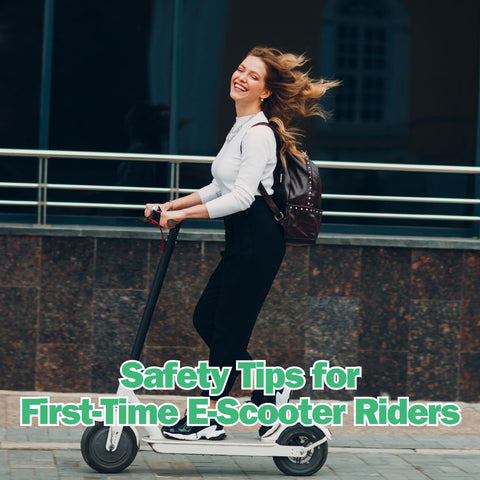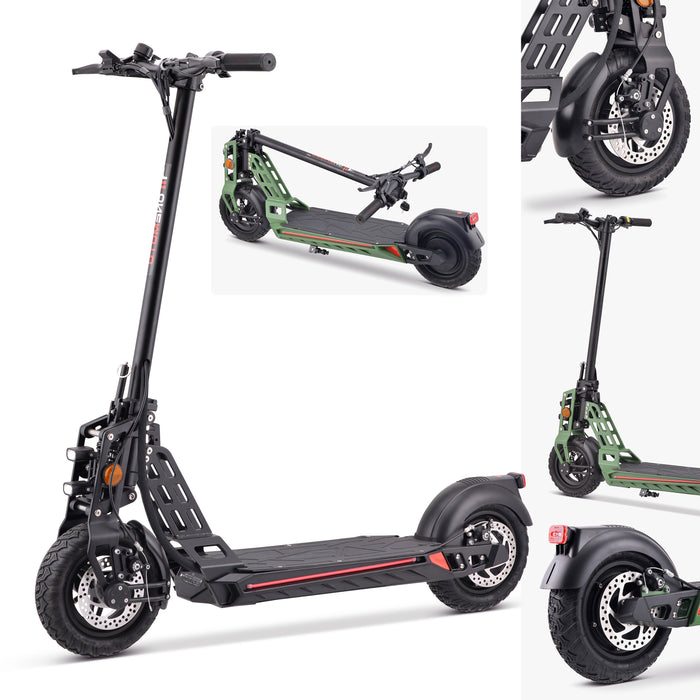
Have you noticed the colourful fleets of electric scooters lining the sidewalks of your city?
Well, they’re not just for kicks and giggles. These nifty gadgets are revolutionising the way we think about getting from Point A to Point B, especially those tricky last-mile trips that are too long to walk but seem silly to drive.
Let’s dive into how electric scooters are changing the face of urban mobility, for better or for worse.
The Good Stuff
Environmental Impact
First off, electric scooters are like a breath of fresh air—literally.
Ditching petrol for electricity means they’re cutting down on air pollution and greenhouse gas emissions.
It’s a win for the planet and a breath of fresh air for city-dwellers tired of smog and soot.
Electric Scooter Lifecycle Analysis
While electric scooters offer a greener alternative for city commutes, their environmental footprint extends beyond just emissions during use.
A comprehensive look at their lifecycle—from manufacturing and battery production to eventual disposal—sheds light on their true environmental impact.
For instance, the sourcing of lithium for batteries raises questions about sustainable practices, while the energy used in manufacturing and the recyclability of scooters are critical factors in assessing their overall eco-friendliness.
Efforts to extend scooter lifespans and improve battery recycling processes are key to maximising their environmental benefits.
Traffic Congestion?
No, Thanks!
If you’ve ever been stuck in traffic, you know the frustration.
Electric scooters offer a nifty solution, zipping through traffic and freeing up the roads.
Imagine a world with fewer cars and more scooters; it sounds pretty peaceful, doesn’t it?
Keeping Wallets Happy
Compared to owning a car, electric scooters are a no-brainer for the budget-conscious.
Low maintenance, no gas bills, and you can dodge those pesky parking fees.
It’s like giving your wallet a little hug every time you ride.
Comparative Cost Analysis
How do electric scooters stack up against other transportation options in terms of cost?
A detailed comparison reveals that electric scooters are not only cheaper than owning a car (when factoring in gas, insurance, and maintenance) but also often more economical than ride-sharing services for short trips.
However, the cost advantage can vary based on usage patterns, with frequent riders benefiting most.
This analysis helps readers understand the cost dynamics at play, making it easier to choose the most economical mode of transport for their needs.
Accessible to All
Electric scooters are the great equalizer. They bridge the gap for those short trips that are just out of walking distance and can be a game-changer for people with limited mobility.
Plus, they’re just plain fun to ride.
But Wait, There’s More (And It’s Not All Rosy)
Safety First (Or Should Be)
Let’s talk safety. With great power comes great responsibility, and some riders and cities are still figuring that out.
Cluttered pavements and the occasional daredevil rider can pose risks to both riders and pedestrians.
Rider Safety Tips and Gear
Navigating the urban jungle on two wheels comes with its risks.
Whether you're weaving through rush-hour traffic or cruising down quiet side streets, staying safe on an electric scooter requires both common sense and a bit of preparation.
Here's how to ensure your ride is as safe as it is enjoyable:
Safety Tips:
- Obey Traffic Laws: Just because you're on a scooter doesn't mean you're above the law. Stop at red lights, yield to pedestrians, and follow the same rules cars do. It keeps you safe and maintains harmony on the roads.
- Be Mindful of Pedestrians: Sidewalks are for walking, not scootering. If you must ride on the sidewalk briefly, go slow, and yield to pedestrians. A simple bell or a friendly "on your left" can prevent collisions.
- Ride Sober: Scootering while impaired isn't just illegal; it's dangerous. Keep your wits about you and save the drinks for when you’re not operating anything with wheels.
- Stay Alert: Keep your eyes peeled for road hazards like potholes, uneven surfaces, and slippery wet leaves. Also, be wary of car doors opening and pedestrians stepping into the street unexpectedly.
- Plan Your Route: Before you head out, plan a route that uses bike lanes or quieter streets. Apps and maps often have bike-friendly directions that work well for scooters too.
Must-Have Gear:
- Helmet: This is non-negotiable. A helmet can save your life, so make sure it's properly fitted and meets safety standards.
- Reflective Clothing: Especially important for early morning or nighttime rides, reflective clothing makes you more visible to drivers.
- Lights: Equip your scooter with a bright front light and a red rear light. It’s crucial for being seen and for seeing your path after dark.
- Gloves: In a fall, hands often hit the ground first. Gloves can protect your palms from scrapes and provide a better grip on the handlebars.
- Knee and Elbow Pads: For extra protection, especially for new riders or those tackling more challenging routes, knee and elbow pads can prevent injuries from falls.
Emphasising safety can help mitigate risks, making scooter riding a safer choice for everyone.
Where Do I Park This Thing?
As much as we love them, scooters strewn about the city can be an eyesore and a hazard.
Cities and companies are brainstorming ways to keep scooters accessible without turning sidewalks into obstacle courses.
City Planning and Scooter Integration
How are cities adapting to the surge of electric scooters?
From designated parking zones to expanded bike lanes, urban planners are rethinking city infrastructure to accommodate this new mode of transport.
This section explores innovative solutions being implemented around the globe, highlighting the importance of thoughtful planning in maximising the benefits of electric scooters while minimising disruptions.
Navigating the Rules
Regulations for electric scooters are still a bit like the Wild West. As cities catch up, there’s a fine line between fostering innovation and ensuring public safety.
It’s a balancing act that requires careful thought and cooperation.
Looking Ahead: The Road to Integration
Best Buddies with Public Transit
Electric scooters and public transport are becoming fast friends.
Scooters can fill in those gaps in the transit system, making your journey smoother and more efficient.
It’s all about options, and scooters are adding an important one to the mix.
Changing Our Travel Habits
The rise of electric scooters is encouraging people to rethink their daily commutes.
Ditching the car for shorter trips can ease traffic congestion and reduce pollution, all while giving you a fresh perspective on your city.
A Boost for the Economy
The electric scooter boom is not just good for the environment; it’s also sparking economic opportunities.
From jobs in scooter maintenance and charging to the growth of sharing services, there’s a whole ecosystem developing around these two-wheelers.
Global Regulatory Perspectives
The regulatory landscape for electric scooters is as varied as the cities they occupy.
Some cities embrace them with open arms, offering subsidies and support, while others impose strict regulations or outright bans.
By examining different regulatory approaches, readers can gain insights into the challenges and opportunities presented by electric scooter proliferation and the key factors driving successful integration.
The Future is Bright (and Electric)
Innovation in scooter technology is accelerating. Think of longer battery life, smoother rides, and smarter scooters that can tell you the best route to take.
The potential for electric scooters to integrate with smart city initiatives is huge, paving the way for a more connected, efficient urban experience.
Future Tech in Electric Scooters
What does the future hold for electric scooters?
Imagine scooters that can dock and charge themselves, navigate autonomously to balance fleet distribution, or offer enhanced security features through biometric locks.
This section delves into the cutting-edge technologies that are on the horizon, promising to make electric scooters even more efficient, user-friendly, and integrated into our digital lives.
Wrapping Up: A Scooter in Every Driveway?
So, what does the future hold for electric scooters in urban transportation?
The possibilities are as wide as the roads (and bike lanes) they travel on.
With ongoing advancements in technology and infrastructure, coupled with a mindful approach to safety and regulations, electric scooters could very well become the go-to for last-mile travel.
In the meantime, why not give one a spin?
It’s a small step (or ride) toward a more sustainable, accessible, and fun urban future.
And who knows?
You might just find yourself smiling all the way to your destination.
Get in Touch 🚀
Loved our article on “How Electric Scooters Are Changing the Face of Last-Mile Transportation” Got the itch to dive into more wheely-awesome info?
Whether you're a parent or a grandparent, we're here for all your kids ride-on toy questions! 🚗💨
Feeling click-happy?
Jump straight into our wonderland at RiiRoo.com.
Or, if you're more the chatty type, give our Live Chat a whirl and let's talk toys!









Share:
How to Plan Long-Distance Trips with Electric Scooters
E-Scooter Riding Etiquette: Dos and Don'ts